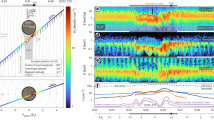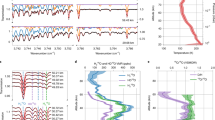Abstract
THE high abundance ratio of deuterium to hydrogen in the atmosphere of Venus (120 times that on Earth) can he interpreted either as the signature of a lost primordial ocean1, or of a steady state in which water is continuously supplied to the surface of Venus by comets or volcanic outgassing, balancing loss through hydrogen escape2,3. New observations4–6 of a water concentration of only 30 parts per million in Venus' atmosphere imply that the residence time of water in the atmosphere, before it escapes to space, is short compared with the age of the Solar System, casting doubt on the primordial ocean hypothesis. But a recent theoretical reanalysis of collisional ejection7 has increased estimates of the deuterium escape efficiency by a factor of 10: this means that if the venusian water budget is in steady state, the D/H ratio of the source water must be 10–15 times higher than that on Earth, ruling out cometary water, whose D/H ratio is thought to be lower than this8. Here I suggest that these observations can be understood either as the result of continuous outgassing from a highly fractionated mantle source (such as might result from severe dessication of the mantle, or massive hydrogen escape early in the planet's history) or Rayleigh fractionation after massive outgassing from catastrophic resurfacing of the planet in the past 0.5–1 Gyr.
This is a preview of subscription content, access via your institution
Access options
Subscribe to this journal
Receive 51 print issues and online access
$199.00 per year
only $3.90 per issue
Buy this article
- Purchase on Springer Link
- Instant access to full article PDF
Prices may be subject to local taxes which are calculated during checkout
Similar content being viewed by others
References
Donahue, T. M., Hoffman, J. H., Hodges, R. R. & Watson, A. J. Science 216, 630–633 (1982).
Grinspoon, D. H. Science 238, 1702–1704 (1987).
Grinspoon, D. H. & Lewis, J. S. Icarus 74, 21–35 (1988).
Pollack, J. B. et al. Icarus (in the press).
de Bergh, C. et al. Adv. Space Res. (in the press).
Donahue, T. M. & Hodges, R.R. Papers presented to int. Colloq. Venus, LPI Contrib. No. 789 (1992).
Gurwell, M. A. & Yung, Y. L. Planet. Space Sci. (in the press).
Eberhardt, P. et al. Astr. Astrophys. 187, 435–437 (1987).
Rodriguez, J. M., Prather, M. J. & McElroy, M. B. Planet. Space Sci. 32, 235–1355 (1984).
Donahue, T. M. & Hartle, R. E. Geophys. Res. Lett. 19, 2449–2452 (1992).
Brace, L. H. et al. J. geophys. Res. 92, 15–26 (1987).
Hodges, R. R. & Tinsley, B. A. J. geophys. Res. 91, 13649–13658 (1986).
Grinspoon, D. H. Papers presented to int. Colloq. Venus, LPI Contrib. No. 789. (1992).
Hunten, D. M., Donahue, T. M., Walker, J. C. G. & Kasting, J. F. in Origin and Evolution of Planetary and Satellite Atmospheres (eds Atreya, S., Pollack, J. B. & Matthews, M.S.) 386–422 (Univ. of Arizona Press, 1989).
Lewis, J. S. & Grinspoon, D. H. Science 249, 1273–1275 (1990).
Donahue, T. M. & Hodges, R.R. J. geophys. Res. 97, 6083–6091 (1992b).
Krasnopolsky, V. A. Icarus 62, 221 (1985).
Head, J. W., Crumpler, L., Aubele, J., Guest, J. & Saunders, R. S. J. geophys Res. 97, 13153–13197 (1992).
Phillips, R. J. et al. J. geophys. Res. 97, 15923–15948 (1992).
Schaber, G. G. et al. J. geophys. Res. 97, 13257–13302 (1992).
Bullock, M. A., Grinspoon, D. H. & Head, J. W. Papers presented to int. Colloq. Venus, LPI Contrib. No. 789 (1992).
Moore, J. G. Contrib. Mineral. Petrol. 28, 272 (1970).
Head, J. W., Parmentier, E. M. & Hess, P. C. Papers presented to int. Colloq. Venus. LPI Contrib. No. 789 (1992).
Turcotte, D. Papers presented to int. Colloq. Venus, LPI Contrib. No. 789 (1992).
Pollack, J. B., Toon, O. B. & Boese, R. J. geophys. Res. 85, 8223–8231 (1980).
Kumar, S., Hunten, D. M. & Pollack, J. B. Icarus 55, 369–389 (1983).
Kasting, J. F. & Pollack, J. B. Icarus 53, 479–508 (1983).
de Bergh, C. et al. Science 251, 547–549 (1991).
Author information
Authors and Affiliations
Rights and permissions
About this article
Cite this article
Grinspoon, D. Implications of the high D/H ratio for the sources of water in Venus' atmosphere. Nature 363, 428–431 (1993). https://doi.org/10.1038/363428a0
Received:
Accepted:
Issue Date:
DOI: https://doi.org/10.1038/363428a0
This article is cited by
-
Venus’s atmospheric nitrogen explained by ancient plate tectonics
Nature Astronomy (2023)
-
Dynamics and Evolution of Venus’ Mantle Through Time
Space Science Reviews (2022)
-
The Long-Term Evolution of the Atmosphere of Venus: Processes and Feedback Mechanisms
Space Science Reviews (2022)
-
Strength models of the terrestrial planets and implications for their lithospheric structure and evolution
Progress in Earth and Planetary Science (2021)
-
Day–night cloud asymmetry prevents early oceans on Venus but not on Earth
Nature (2021)
Comments
By submitting a comment you agree to abide by our Terms and Community Guidelines. If you find something abusive or that does not comply with our terms or guidelines please flag it as inappropriate.



